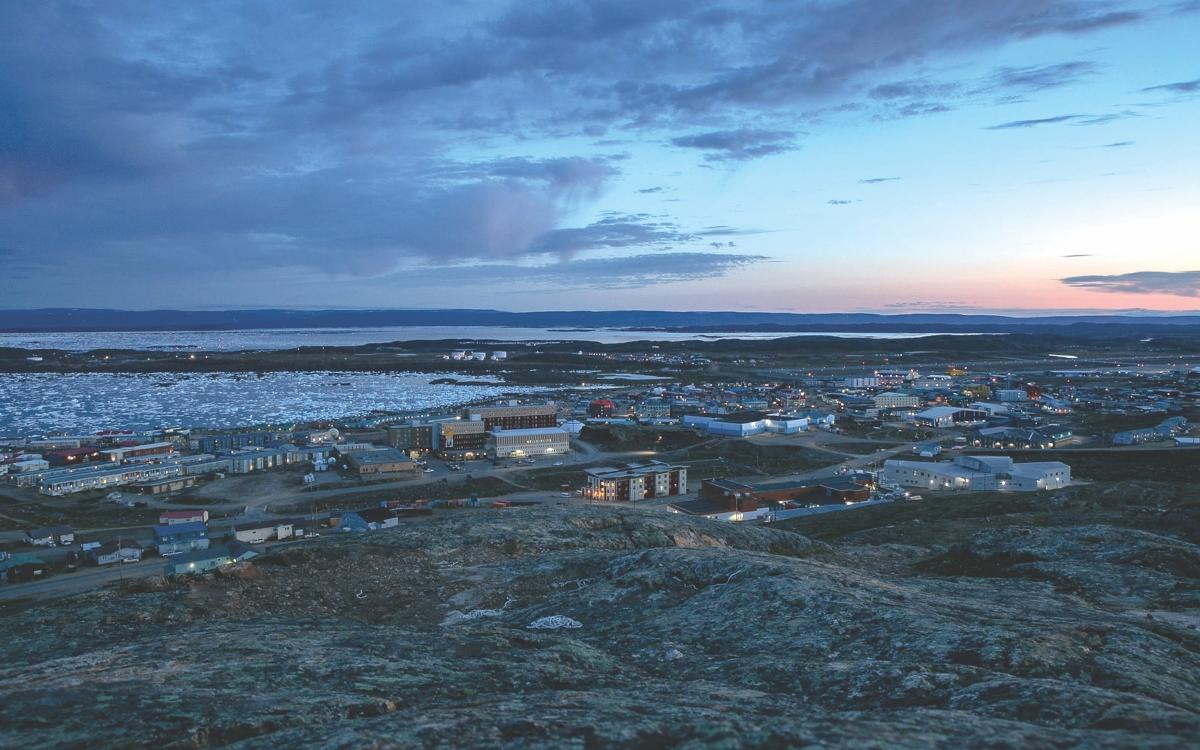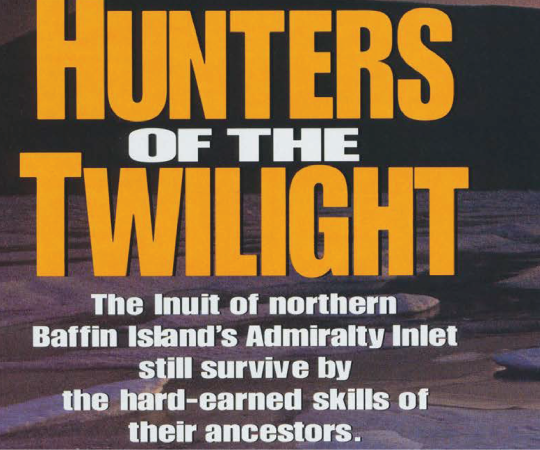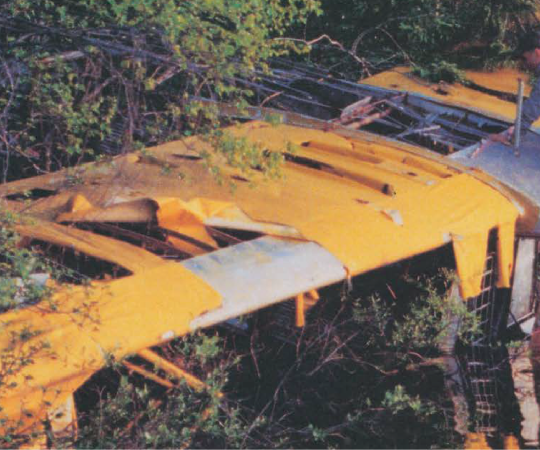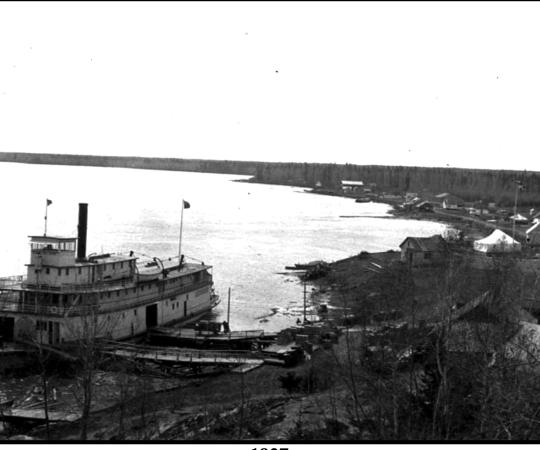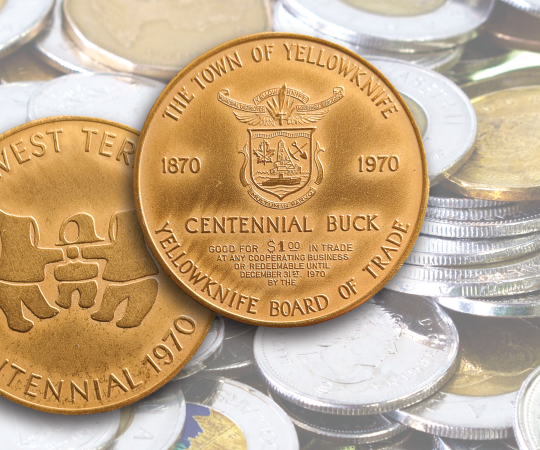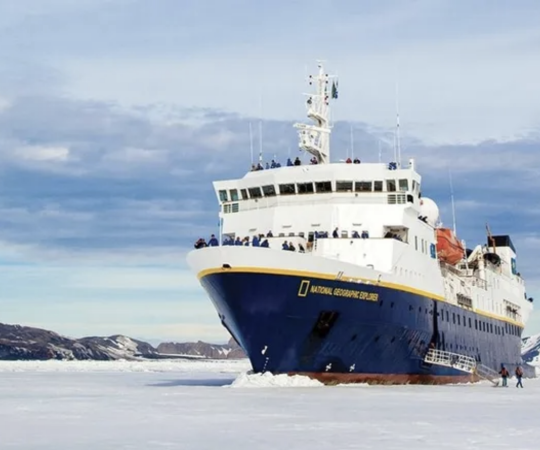When Rosemarie Kuptana thinks about growing up on Banks Island, she remembers a life tied to the seasons. The Inuvialuit leader was born in an iglu in 1954 on the Prince of Wales Strait, where her family hunted seals.
“We followed the seasons of the animals and the birds and fish,” Kuptana says. “In the winter, we would go down to the sea ice, because it was much warmer than the land, and we would build small houses on the sea ice.”
By the late 1950s, that had changed. The Canadian government, wanting to assert its jurisdiction over the islands of the western Arctic, built weather stations in what is now Sachs Harbour and sent in the RCMP to set up a detachment. More Inuvialuit from the outlying regions began to settle permanently in the community.
The transition wasn’t easy, Kuptana says. Her family and community were suddenly subject to a host of new laws and regulations. They were only able to hunt birds at certain times of the year. “These kinds of changes were very intrusive, simply because they were so different for us,” the Elder says. “The way the Canadian government handled that whole jurisdictional issue over the sovereignty of the Arctic… it was an occupation.”
Over the course of Canada’s history, Arctic sovereignty to politicians and bureaucrats in the south has been about demarcating borders, about protecting trade routes and resources, about military defence, and exerting the state’s political control over a vast expanse of land that many
of these decision-makers had never even visited.
The Canadian government took heavy-handed measures to populate the High Arctic with RCMP officers and military personnel and researchers. It manipulated and outright lied to Inuit families, relocating them to austere Arctic locations without providing them the support in food and supplies they would need to thrive. It has taken ideas from one world and tried to make them
fit in another.
But when Kuptana is asked to define Arctic sovereignty, she thinks of home. She thinks about her ancestors, and how they developed their culture, languages, and knowledge systems by living in harmony with the land and water. She thinks about how sovereignty in the Arctic is expressed by the people who have lived there since time immemorial.
“Arctic sovereignty means having the ability to exercise one’s culture based upon the many characteristics that define a people, such as your language, your traditions, values, history, geography,” Kuptana says. “It means sovereignty over decisions that are being made about environmental issues, climate change, wildlife—anything that affects Inuit in particular."
Canada has succeeded, in many ways, in getting its claims to the Arctic recognized by the rest of the world. But in doing so, it has often failed the people who have always inhabited the Arctic—the people who assert Canada’s sovereignty every single day, by making their lives in the North.
So when it comes to Arctic sovereignty, many residents in the region ask: wouldn't Canada's energy be best spent supporting Northern people and communities?
The Arctic is a hot topic in international politics for a reason: it’s warming three times faster than the rest of the world.
The sea ice that has long made the Northwest Passage dangerous and financially unappealing is rapidly retreating. Last year, the United Nations’ Intergovernmental Panel on Climate Change released a major report predicting the entire Arctic Ocean could reach “practically ice-free conditions” at its summer minimum by 2050. At the latest.
Less sea ice means it will be easier to navigate Arctic waters, creating the incentive for new shipping routes that would better connect the East to the West, along with the potential to exploit mineral resources in the Arctic seabed, where an estimated quarter of the world’s remaining natural gas and oil reserves sit. There’s already been a significant jump in the number of vessels traversing the Northwest Passage. Traffic in the long-fabled shipping route, which snakes through Canada’s Arctic Archipelago and along its northern coastline, increased by 44 percent from 2013 to 2019.
This growing spotlight has put Canada on the defensive in the past few decades. Politicians pound their chests, declaring the passage belongs to Canada, reminding other countries to keep that in mind when making plans to venture through. They’ve promised investment after investment in new ports, offshore patrol ships, icebreakers, and High Arctic military bases, all to send a message that they mean business.
For many in the North, these big splashy announcements miss the point—not to mention those promises are slow to actually come through. In its Arctic and Northern Policy Framework, the Canadian government has stated that its stance on Arctic development is to improve the lives of the people who live there. But do big investments in icebreakers and a port in Nanisivik, where nobody lives, really improve the every-day lives of Northerners, when so much community infrastructure is failing, aging out or woefully inadequate?
This list of challenges Northern communities face runs long. Reliable, high-speed internet is rare outside the territorial capitals and it’s incredibly costly compared with southern plans. Residents often need to fly south to receive medical treatments or surgeries for major ailments. When aging diesel plants finally fail, it requires a Herculean effort just to keep the lights on. After the power plant in Pangnirtung, Nunavut caught fire in 2015, officials had to charter the world’s largest cargo plane—an Antonov A-124-100—to fly a heavy-duty helicopter into Iqaluit. Then, that helicopter shuttled four new diesel generators to the Baffin Island community. Even in the past year, Iqaluit—a capital city in Canada—had no clean tap water for months on end, after old tanks cracked and fuel leaked into the city’s water supply. As the climate warms and the Arctic landscape changes, problems like these are only going to intensify.
Northern and Indigenous advocates have long pointed out the discrepancies between living standards in the North and south and how they ultimately undermine the country’s claims to sovereignty in the Arctic. It’s symptomatic of a lack of commitment to the people the government is meant to serve, and how the Arctic—and the rights of its original inhabitants, the Inuit—are often treated as an afterthought.
It’s a point best made by Governor General Mary Simon. In 2008, the Inuk leader—who was president of Inuit Tapiriit Kanatami (ITK) at the time—embarked on a country-wide speaking tour to offer her perspective on how Canada should approach sovereignty amid growing Arctic interest on the international stage.
“For Canada to assert its sovereignty legitimately in the Arctic, it must also ensure that Inuit are treated as all other Canadians are...with the same standard of education, health care, and infrastructure that is the foundation of healthy communities across Canada,” she told crowds.
“It is not enough to pursue an aggressive economic agenda of diamond mines and oil pipelines in the Arctic, if Inuit continue to live at standards well below what average Canadians expect and enjoy. The process for asserting Canada’s sovereignty in the Arctic involves establishing constructive partnerships with Inuit.”
In other words, Simon argued, sovereignty needs to begin at home.

On May 25, 1993, representatives from the Canadian government, the Government of the Northwest Territories, and the Tunngavik Federation of Nunavut (now Nunavut Tunngavik Incorporated, or NTI), sat together at a table in Iqaluit. There laid out before them was one of the most important Canadian political documents
of the 20th century: the Nunavut Land Claim Agreement.
This document would transfer the title of 350,000 square kilometres from Canada to Inuit in the Eastern Arctic. It was the biggest land claim in Canadian history and eventually created the territory of Nunavut in 1999. It enshrined Inuit rights to use the lands and waters as they always had, laid the basis for a new public government to be staffed and led by Inuit, and set out clear processes when it came to developing mineral resource projects on Inuit lands and water. Negotiators were even sure to insert a provision affirming that Canada’s claims to Arctic sovereignty rested on Inuit use and occupancy of the land.
Alongside other major land claims—the James Bay and Northern Québec Agreement of 1975, the Inuvialuit Final Agreement in 1984, and the Gwich’in Comprehensive Land Claim Agreement of 1992—the Nunavut Land Claim Agreement seemed to signal a shift in the way Canada aimed to assert its sovereignty. No longer did power and control rest exclusively with the state. Instead, it was one to be shared with the Inuit and First Nations who had lived there long before Canada existed. Canada recognized the necessity of their role.
“There’s an interesting line of argument that has been put forward by a number of different Inuit scholars and academics and writers, saying that the Nunavut Land Claim Agreement forms the social contract between Inuit and Canada,” says Will Greaves, a professor of international relations at the University of Victoria.
In this sense, Greaves says, it’s almost transactional—Inuit would extend their own inherent sovereignty in the Arctic to Canada and, in exchange, Canada would ensure a higher quality of life
for Nunavummiut.
Nearly 30 years later, many of the agreement’s key provisions have yet to be implemented. Article 23, for instance, promises the percentage of Inuit that make up Nunavut’s population—roughly 85 percent—would be reflected in the territorial government’s workforce. Yet a report issued last year showed Inuit make up just 50 percent of that workforce—and only 20 percent of senior management staff. And as Inuit in Nunavut continue to suffer from pervasive household food insecurity, a lack of adequate housing, high suicide rates, and widespread poverty, Canada’s failure to uphold its end of the bargain has been laid bare.
“There’s been a growing frustration about how Inuit are not being served as well as they should be,” says Aluki Kotierk, president of NTI, which represents the 30,000 Inuit living in Nunavut. In short, she says, life for Inuit has not been getting better.
Territorial and federal spending in Nunavut rarely reflect Inuit needs, Kotierk continues. “You see large sums of money being spent on jails or the correctional system, while in comparison, there’s much less money being spent on early childhood education or daycares. So you question: where are the priorities?”
Last November, NTI announced its intention to pursue self-government negotiations with the Government of Canada. According to Kotierk, the goal is to put power back into the hands of Inuit, so Nunavummiut can achieve the quality of life they were promised, but on their own terms.
“Ultimately, we would like to see that Inuit’s basic needs are being met,” she says, “that services are available in Inuktut, that programs and services are created with the Inuit worldview in mind, with Inuit cultural values, so that it does not feel so foreign. So that Inuit are able to live in dignity and receive programs and services that understand who they are.
“That’s what we’re working towards—making life better for Inuit.”
To Greaves, these failures to adequately serve Inuit throw the whole modern notion of Arctic sovereignty in Canada into doubt. “It’s a question of, is there food and housing and fresh water and sanitation and basic infrastructure that the Government of Canada, broadly speaking, is obliged to provide,” he explains.
When Canada fails to uphold the commitments it’s made to Nunavummiut—the people who extend their inherent sovereignty over the Arctic to the Canadian state—it undermines its own assertions
of Arctic sovereignty.
“We should view all of those kinds of critical infrastructure problems as sovereignty related issues,” says Greaves.
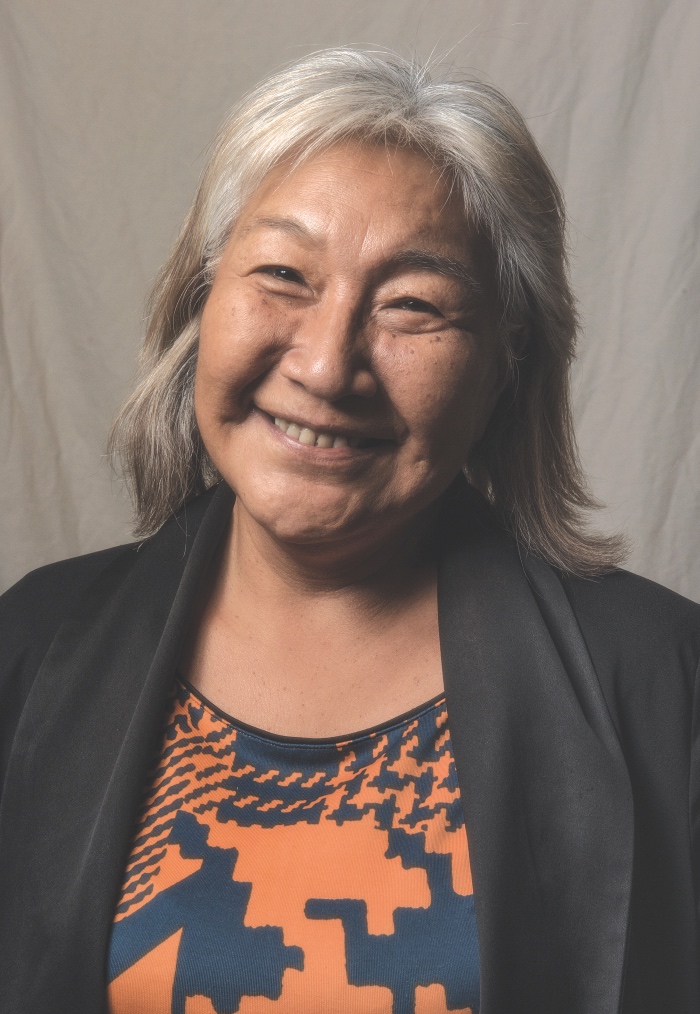
But Northerners aren’t just waiting for southerners to shape the Arctic anymore.
The Inuit Circumpolar Council (ICC) —made up of Inuit leaders from across Greenland, Canada, Alaska, and Russia—released the Circumpolar Inuit Declaration on Sovereignty in the Arctic in 2009. It pushed for a fundamental shift in the way the issue was approached on the global stage–one that centres on collaboration between countries through forums like the Arctic Council. The shared vision focuses on the health and sustainability of Arctic communities, and actively includes Indigenous peoples in decision-making processes.
In Canada, Northerners are also taking tangible sovereignty matters into their own hands. NTI started the Inuit Marine Monitoring Program in 2017, hiring Inuit hunters in six coastal Nunavut communities to keep watch over the nearby waterways. The monitors collect data on the ships that pass through the Northwest Passage using vessel tracking technology to better understand how increased marine traffic is affecting wildlife in the area. ITK continues to advocate on behalf of Inuit across the country, and has released strategies on how to best address issues such as food insecurity, improve education within Inuit communities, and the impacts of climate change.
Kuptana reflects on the importance of making Inuit and First Nations equal partners in the conversation about the future of the Arctic. It’s something she has spent her entire career fighting for, having served as president of both ICC and ITK.
“We have got to get rid of all these old notions of this ‘gray suit club’ only,” Kuptana says. “Discussions of Arctic sovereignty have to be more inclusive, because they do need our traditional [Inuit] knowledge in respect to the land and the animals, and they need to share power.
“That is what Arctic sovereignty is about: that we have the security of our homeland.”
Kuptana emphasizes the word ‘we.’

